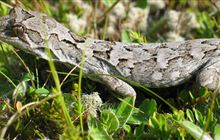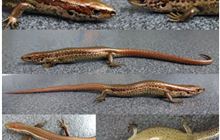Report a reptile or frog sighting
Introduction
Use the Amphibian and Reptile Distribution Scheme (ARDS) cards to report sightings of amphibians and reptiles, and help us build our database.Download and send ARDS cards
Download and complete the Amphibian and Reptile Distribution Scheme (ARDS) cards. Your information will help us gather information for the herpetofauna database.
Send completed cards to:
Herpetofauna database administrator
PO Box 10420
Wellington 6143
herpetofauna@doc.govt.nz
How to fill in ARDS cards
When filling in the card ensure that either a legible, sharp pencil or a ballpoint pen is used.
Distribution scheme cards can be filled in by anyone who can identify amphibians and reptiles accurately or who can take a good photograph.
Cards can be filled in at any time of year, but many amphibians and reptiles are most likely to be visible over the spring - summer - autumn period. A new card should be filled in for each change in location or new day.
Card No./Code:
Leave blank.
Observer:
Enter your name (or if more than one person is involved in the observation, the leader’s name) on every card filled in. Cards are coded on the computer using the first four initials of the observer’s name.
On the first card completed it is useful to give full names. After that you can use your initials.
Address:
For each series of cards filled in make sure that the address is on the first card of the series. Let us know if your address changes after filling in the cards, in case we need to contact you.
Affiliation:
Enter the name of the organisation that this survey is being done for, e.g. Landcare Research, a university, Department of Conservation. If you are acting as a private individual, note this as ‘none’.
Date:
Enter the day, month and year, as follows e.g. 17.7.09.
Alt (m):
If you have access to a Global Positioning System (GPS) unit, you should use this where possible, as the unit will record altitude when recording the grid reference.
Include the grid reference accuracy + in metres.
Altitude can also be determined manually using a Topo50 or NZMS 260 series topographical map.
Locality:
From the map used give the locality name nearest to your sighting and, if possible, provide a more detailed general location name. This location name can be used for detecting errors in the grid reference.
Series:
Give the New Zealand map series number of the map being used in the Topo50 or NZMS 260 series (1:50,000: 2 cm to 1 km). Do not use any other map series.
Grid reference:
If you have access to a Global Positioning System (GPS) unit, you should use this where possible. Note the Easting and Northing or Latitude or Longitude and include the accuracy + in metres.
If you do not have access to a GPS unit, you can get the grid reference from a Topo50 or NZMS 260 series topographical map. If possible give a full grid reference defining the location of the sighting to the nearest tens of metres. This results in a 14-digit number on metric maps, divided into two parts - an Easting and a Northing.
The easting is read from the top or bottom edge of the map.
This procedure is repeated for the northing using the horizontal line directly below the sighting as a reference point. In most cases we can accept observations given to the nearest 100 metres.
Species name:
Enter the names of all species seen at a given grid reference using the DOC nomenclature provided in the species names table.
If you do not know the species name send us a photograph.
Number (No.):
Where possible give the number of individuals seen for each species.
Time:
Note the time at which the animals were seen in 24-hour clock notation, e.g. 2:05 pm = 1405 hours (note S if in summertime [to account for daylight saving]).
Habitat:
Circle one or more of those habitats listed which most closely describe where the observations were made. As an example, Central Otago high country is a mixture of farmland and tussockland with some scrub. The coding could therefore be 9/8/5. Code numbers 18 and 19 are left blank for your definition.
Also circle up to two categories of the microhabitat definitions. These categories can be taken as broad definitions, i.e. ‘D’, under stones can be defined as under boulders, concrete slabs, bricks, etc.
If more than one species is being recorded and the habitat types differ, the various habitat choices can be written in the space provided and marked ‘Habitat’.
Weather:
Circle the appropriate category for ‘Light’, ‘Temperature’ and ‘Wind’ at the time of the observation.
Voucher specimen/photograph:
Permits issued by the Department of Conservation are required before protected species can be captured and handled (see ‘Permits’). Such species should only be captured and removed under exceptional circumstances.
Photographs are a particularly useful check for identification. If an animal was captured and removed, or photographed, indicate this.
Extra notes:
If extra notes were recorded about the animal seen (e.g. weight, measurements, general description), or about the area in which the animal occurred, circle the appropriate category. Notes can be written on the back of the card.
Identified by:
If the observer was not the person who identified the animal then enter the identifier’s name.
Authority used:
Cite the reference or contact used to identify the species name of the animal. If you are considered an authority in the present identification of the species, you may use your own name.


